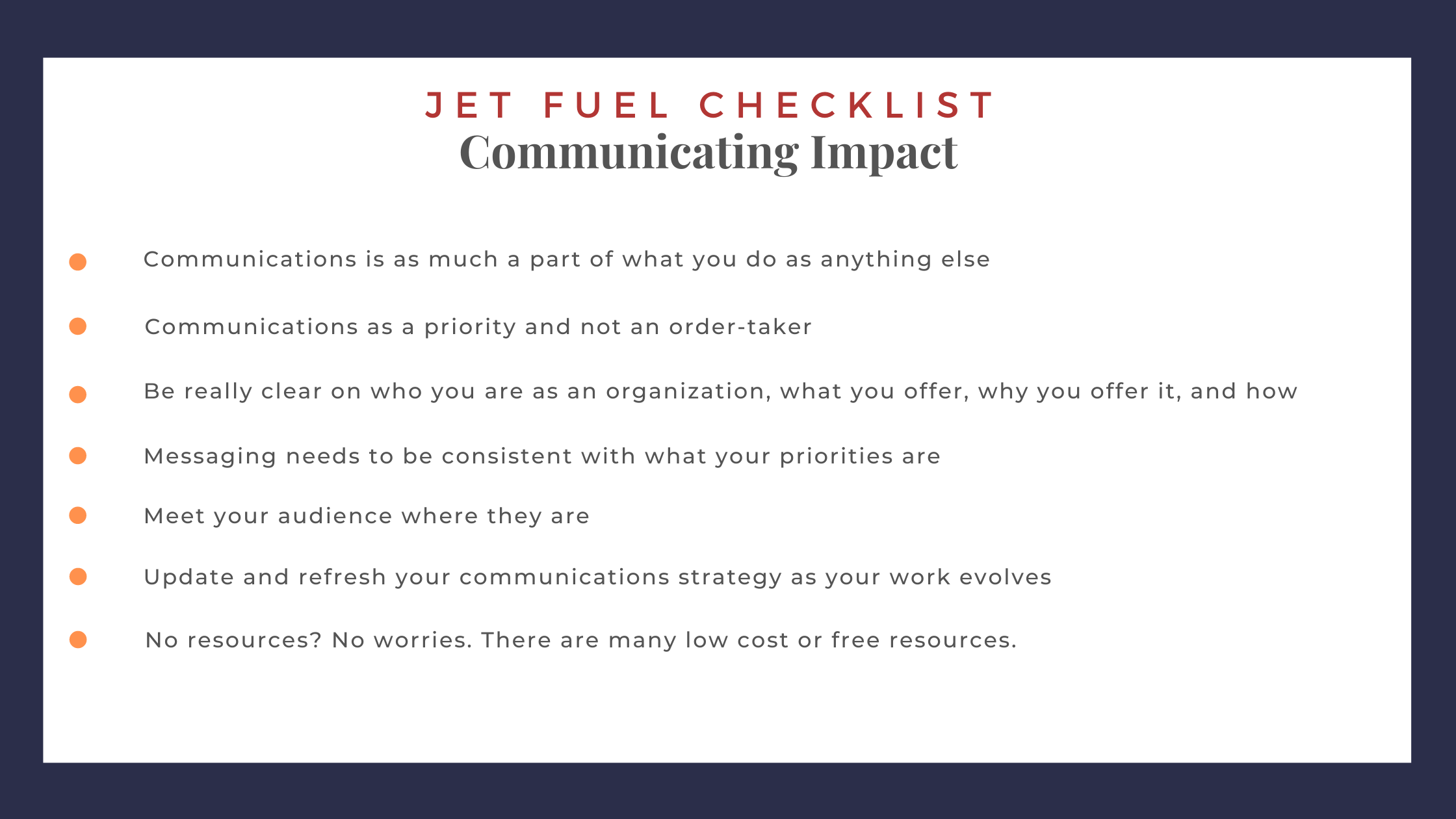The Jet Fuel Series: A conversation with Armetta Parker, communication strategist and nonprofit leader
Communications strategy is an area that often suffers the same fate as many topics featured in this Jet Fuel Series. Like equity, design, and fundraising, communication is another vital tool to a mission-driven enterprise’s effectiveness and sustainability that takes a backseat to delivering programs and services. It’s just that time, dollars, and expertise are tough to come by, particularly if you’re working with a skeleton crew on a shoestring budget.
After all the conversations with experts we had for the Jet Fuel Series, we think it’s important to underscore from the start a few general, somewhat liberating truths we’ve learned and are applicable to all these elements that ten to get put off even though they’re universally perceived as vital. First, there are almost always free and no-cost resources and services out there, especially for helping cause-minded folks get started. Second, getting started doesn’t have to be an overwhelming project.
“Communications should be as much a part of what you do as anything else,” says Armetta Parker. “It’s not a one-and-done if an organization looks at it as part of its business model and its marketing mix.”
Armetta, who joined the Caravanserai Project Board in 2020 and has extensive experience in the communications field, recently offered up some insights on what mission-driven enterprises can do to get their communications strategy off the ground. Her insights include tactical steps, resources you can consult to refine and inform your strategy, and overarching wisdom to help keep the point of communications relative to your mission in focus.
Where to start
Developing a communications strategy from scratch starts with who you are and who you’re talking to. It sounds so simple as to be self-evident, but as Armetta points out, it can take time to pin down for a young enterprise.
“You may or may not have identified your market, intended audience, competition, or environment you’re working in,” says Armetta. “In my mind, your messaging needs to be consistent with what your priorities are. Plus, you need to meet people where they are. Where people are today is probably not where they were 12 or 18 months ago.”
Armetta’s insight on how the “where” evolves is significant. And if you bear it in mind from the get-go, you can establish a habit of assessing your messaging and vehicles for reaching your audiences to ensure that your strategy evolves as you do.
And there’s a nuanced but related point that stood out in our recent conversation about communications strategy: once you view that aspect as part of your work, it becomes integrated with how you do business, as opposed to a daunting, standalone rite of passage to dread and stress about.

“Some aspects of your messaging will be evergreen,” says Armetta. “Other aspects will evolve over time based on how mature you are as an organization, what your offerings are, and your reason for being and existing — which may very well change.”
When to refresh
While Armetta stresses that it’s important to develop a communications strategy with the assumption that you’ll update it as your work evolves, she also offers some guidance on loose intervals for review, as well as telltale signs that you may need a substantive overhaul.
“I don’t think that people have quarterly or annual reviews anymore because these days it’s like minute-by-minute,” says Armetta. “But I would certainly say that every year you are looking to accomplish something.”
In Armetta’s view, if communications is part of your enterprise’s DNA, it should reflect and drive what you are trying to do on at least that year-to-year scale.
“There used to be this notion of having a five-year plan, and maybe you still have something like it but you’re looking at it annually,” says Armetta. “A lot of organizations that I work with now have a two-year plan. I try to have what I call an annual plan, but it’s subject to a review interval of 60 to 90 days.”
In some cases, your plan might need more than a routine review. “One of the early signs that you need to review is if there is a crisis and things aren’t working, and you’re not prepared to deal with it,” says Armetta.
She adds that if you’re finding yourself in crisis mode all the time, that’s also a red flag. “Unless the crisis is an external scandal or a public problem that affects the viability of your organization, you probably need to evaluate how well your strategy is serving you.”
Communications and fundraising
It’s misguided to look at communications as a function of fundraising. And yet, the communications as “order taker” fallacy is something that Armetta has witnessed many times in her long career.
“In all sorts of organizations, the communications team is an order-taker. It’s, ‘Hey, I need a brochure for this campaign’ or a press release, or an infographic, or a blog.”
She describes that kind of stratification of functions as a “prescription for not being as successful as you could.” In many ways it’s the opposite of what she means by having an integrated communications strategy. In contrast, when communications and fundraising functions are developed and leveraged with a holistic grounding in goals, they can be extremely symbiotic.
“I have had a high level of frustration with the impulse reaction of ‘Yes! Now, how do we do this?’ that you see in so many organizations,” says Armetta. “You cannot be all things to all people. What you want to be focused on is the highest and best use of your time and ability.”
Armetta stresses the importance of your messaging reflecting that: the highest and best use of your time and ability. It’s also the key to landing a business model you can sustain, which is vital to resisting the precarious but all-too-common temptation to chase funding.
“At the beginning stages of whatever that is, you should be looking at what the communications vehicles are going to be. Those should be chosen based on who you are speaking to and what you are hoping to accomplish.
“Funders, granters, people who use your services — there are multiple audiences, and you need to understand them and know what you’re trying to say to all of them,” says Armetta.
Low- or no-cost resources and services
“They say that if you have something like 75 LinkedIn connections, there’s no one on there that you can’t reach,” says Armetta. “Don’t be afraid to leverage that, and to ask questions. What’s the worst that can happen?”
Something that we’ve said before in this series is that your mission is your biggest asset. That holds up in the context of communications, not just because it should be the basis of your messaging, but also because you cannot underestimate the resources and expertise that are often available to those with a worthy mission.
“If you are running the organization, you may not be able to devote a lot of time to communications,” says Armetta. But that doesn’t mean there aren’t other options. “Volunteers and students are big ones. Even with higher education evolving, there is still the notion of internships and apprenticeships. And there are organizations that literally exist to provide services for nonprofits that aren’t part of large affiliate organizations.”
Along these lines, Taproot Foundation, We are Change, and VolunteerMarch are platforms dedicated to connecting skilled volunteers offering pro bono services to mission-based groups. Similarly, TechSoup is a source for help in the digital space, including how-tos, webinars, and assessment and strategy services.
On the DIY side, Hubspot is a powerful resource for tools, certifications, software, and free templates to assist with communications planning. Moreover, online searches can often be a gateway to finding exactly what you need, and LinkedIn can be a powerful starting place to connect with experts — many of whom are happy to lend their advice and insight to social causes.
“They say that if you have something like 75 LinkedIn connections, there’s no one on there that you can’t reach,” says Armetta. “Don’t be afraid to leverage that, and to ask questions. What’s the worst that can happen?”
The measure of success
Along with the many insights on building and maintaining an aligned communications strategy, Armetta boils the aim of it all down to this: “First, you need to be really clear on who you are as an organization: What you offer, why you offer it, and how. Second, know who it is that you are speaking to. And third, meet them where they are.”
The strength of your communications strategy is the best measure of your ability to meet people where they are, and its significance as a tool applies to wherever you are.
Whether you’re in the early stages as a startup or revising your strategy to match your evolving mission, you should view communications as a tool to consistently clarify and put into practice that highest and best use of your time and ability.

Armetta Parker is a communication and marketing strategist with a vast public affairs expertise in the public, private and nonprofit sectors. Throughout her career, she has coupled her lived experience, curiosity and passion for diversity and inclusion to her understanding of her professional roles. Her driving principal is “who I am is what I do. What I do is who I am.”
In 2020, Armetta joined the Caravanserai Project board. Armetta holds a bachelors degree in Journalism from Wayne State University. She is a former San Mateo County Commissioner on Aging and previously served on the board of the Wall Street Institute, a DC-based nonprofit focused on youth financial literacy.
The Jet Fuel Series aims to bring different perspectives to the debate that currently dominates the mission-driven sector, addressing the needs of nonprofit or for profit entities alike. Caravanserai Project will publish a monthly blog based on conversations we had with various stakeholders such as futurists, community leaders, academics, entrepreneurs, captains of various industries, from different walks of life and locations whose unique experiences and views hopefully will help us and our network reimagine our efforts in order to increase our impact and advance our missions.






